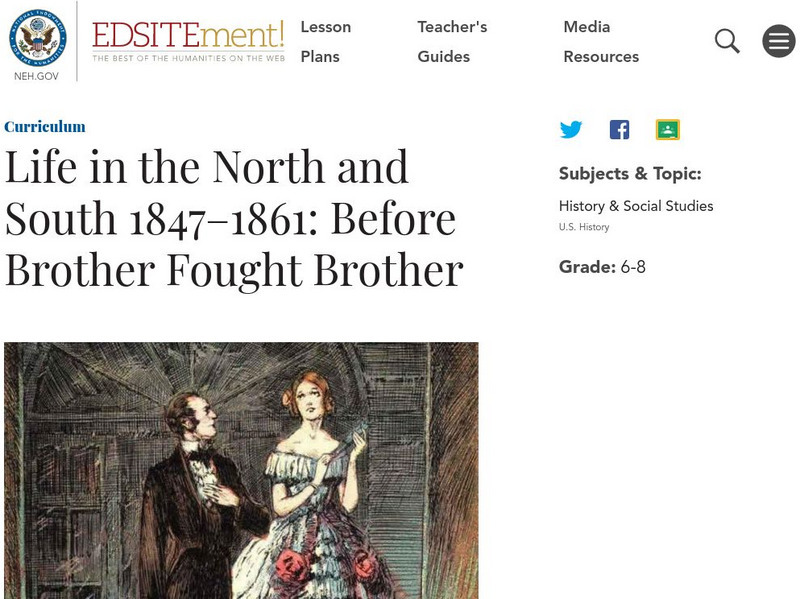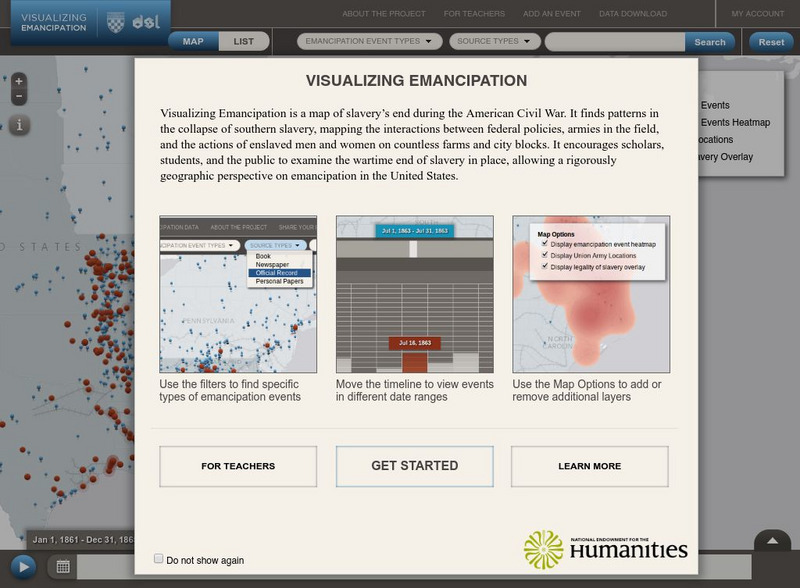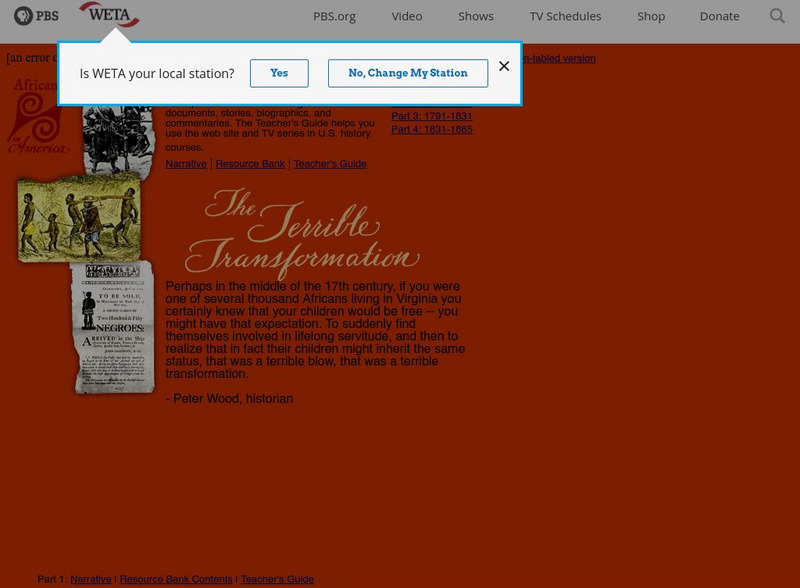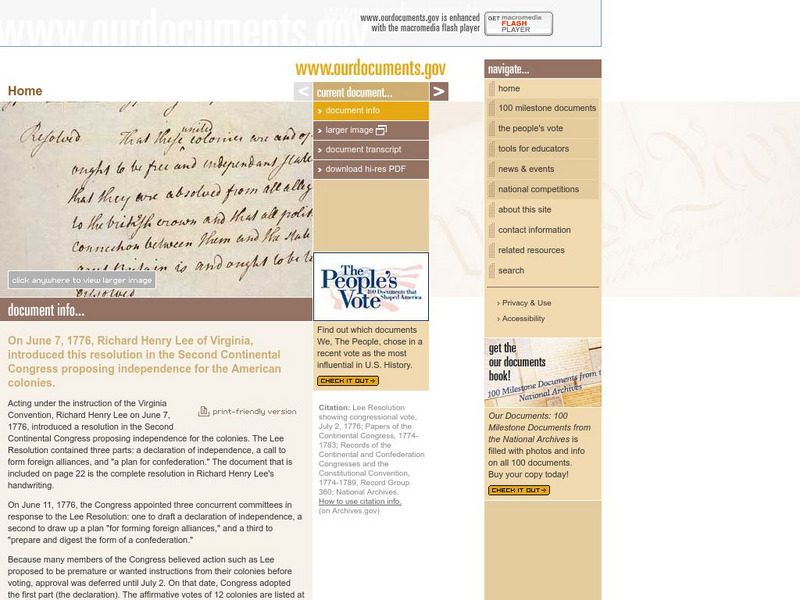Hi, what do you want to do?
Other
Bringing History Home: Segregation History
This 3rd grade unit introduces children to the history of segregation, from the end of the Civil War in 1865 through the 1940s. Its content bridges the period between slavery and the peak of the Civil Rights movement in the 1950s and...
US Department of State
Bureau of International Information Programs: History Outline: Sectionalism
Article reviews several conditions of American society that sowed the seeds of civil war, particularly slavery and sectional conflict.
National Endowment for the Humanities
Neh: Edsit Ement: Life in North & South 1847 1861: Before Brother Fought Brother
The five lessons in this unit are designed to help students develop a foundation on which to understand the basic disagreements between North and South through the investigation of primary source documents, photographs, and census...
University of Richmond
Dsl: University of Richmond: Visualizing Emancipation
A map of slavery's end during the American Civil War. It finds patterns in the collapse of southern slavery, mapping the interactions between federal policies, armies in the field, and the actions of enslaved men and women on countless...
PBS
Pbs: Africans in America
PBS offers a four-part series on the plight of African Americans from slave days to the end of the Civil War. Resources such as interactive maps, a Resource Bank, and Teacher's Guide are available.
Wikimedia
Wikipedia: Harriet Tubman
This article overviews Harriet Tubman's involvement with the Underground Railroad, her service in the military during the Civil War, and her fight as an activist for African-American and women's rights.
University of North Carolina
Documenting the American South: The New Slavery in the South
This autobiography of an African-American man relates his experiences as a free laborer in Georgia after the Civil War. You will see that he felt his conditions were not unlike the slavery that existed before the Civil War. From the...
Columbia University
Columbia University: Columbia University & Slavery 9. John Jay Ii
This website was created by faculty, students, and staff to publicly present information about Columbia's historical connections to the institution of slavery. In the decades before the Civil War, Columbia produced only two graduates who...
PBS
Wnet: Thirteen: Freedom: History of Us: Fatal Contradiction: Missouri Compromise [Pdf]
A lesson plan from the producers of the 16-episode PBS series "Freedom: A History of US" that examines the goal of the Missouri Compromise. A good lesson for comparing and contrasting life in the North and South in the run-up to the...
US National Archives
Nara: Charters of Freedom: End of Slavery in the United States: 13th Amendment
Online exhibit of primary source documents related to the 13th Amendment after the Civil War and the end to slavery.
Digital History
Digital History: What Was Life Like Under Slavery?
A sobering look at the life of the plantation slave in the decades before the Civil War. Read about the malnutrition, severe treatment, and inadequate living conditions.
PBS
Wnet: Thirteen: A War to End Slavery: John Wilkes Booth and Assassination of Lincoln
A lesson plan from the producers of the 16-episode PBS series "Freedom: A History of US" that examines the factors that led John Wilkes Booth to assassinate President Lincoln. Also involves comparing and contrasting Lincoln's and Andrew...
Other
Nutrias Online Exhibits: The World of Francois Lacroix
Traces the life of the richest black man in New Orleans before the Civil War and after.
Library of Congress
Loc: African American Odyssey: Reconstruction and Its Aftermath
From the Library of Congress, this resource documents the course of post-Civil War, post-slavery life for black Americans. Topics include education, constitutional amendments, voting rights and the many challenges African Americans faced...
US National Archives
Our Documents: Emancipation Proclamation (1863)
Image of handwritten copy of Lincoln's Emancipation Proclamation, accompanied by an explanation of the speech's purpose, impact, and role in American history.
Columbia University
Columbia University: Columbia University & Slavery 7. Columbia Faculty
This website was created by faculty, students, and staff to publicly present information about Columbia's historical connections to the institution of slavery. This article discusses the connection between Columbia's faculty to slavery....
PBS
Wnet: Thirteen: The Slave Experience: Legal Rights and Government
Using primary materials and oral histories, PBS tells the story of the slaves' legal rights and their position with the US Government.
University of Oregon
Mapping History: American History
Interactive and animated maps and timelines of historical events and time periods in American history from pre-European times until post-World War II.
Pennsylvania Historical and Museum Comission
Explore Pa History: Pennsylvania Democrats
A good look at the views of the Democratic Party in Pennsylvania just prior to and during the Civil War. Read about Democratic president from Pennsylvania, James Buchanan, and his views about the importance of slavery in the national...
Annenberg Foundation
Annenberg Learner: Opb American History Interactive: Evaluating Evidence
Use this interactive lesson to practice evaluating evidence from primary sources in order to draw conclusions about a historical event. In this particular case, the event is the Civil War. The challenge is to decide for yourself which of...
PBS
Pbs Learning Media: Writing in u.s. History: The Emancipation Proclamation
Assess how the Emancipation Proclamation expanded ideas of freedom and liberty, looking at the antislavery debate that led to the proclamation, the influences on Lincoln's decision, and the provisions of the document. In this interactive...
Independence Hall Association
U.s. History: A House Divided
A very brief overview of the Civil War, the casualties, and the horrific social and economic effects across the nation. Included is a map that shows when each Southern state seceded from the Uniion.
Other
Afgen.com: Address to the Colored People
This page from Afgen.com contains the address delivered to the colored people at Galesburg, Illinois, 1867 by Robert G. Ingersoll. It emphasizes the rights of blacks as a result of the Civil War and Ingersoll encourages African-Americans...
The History Cat
The History Cat: African Americans After the War
Provides a discussion of what life was like for African Americans after slavery ended, focusing on the Freedman's Bureau, Freedman schools, and the Ku Klux Klan.



















